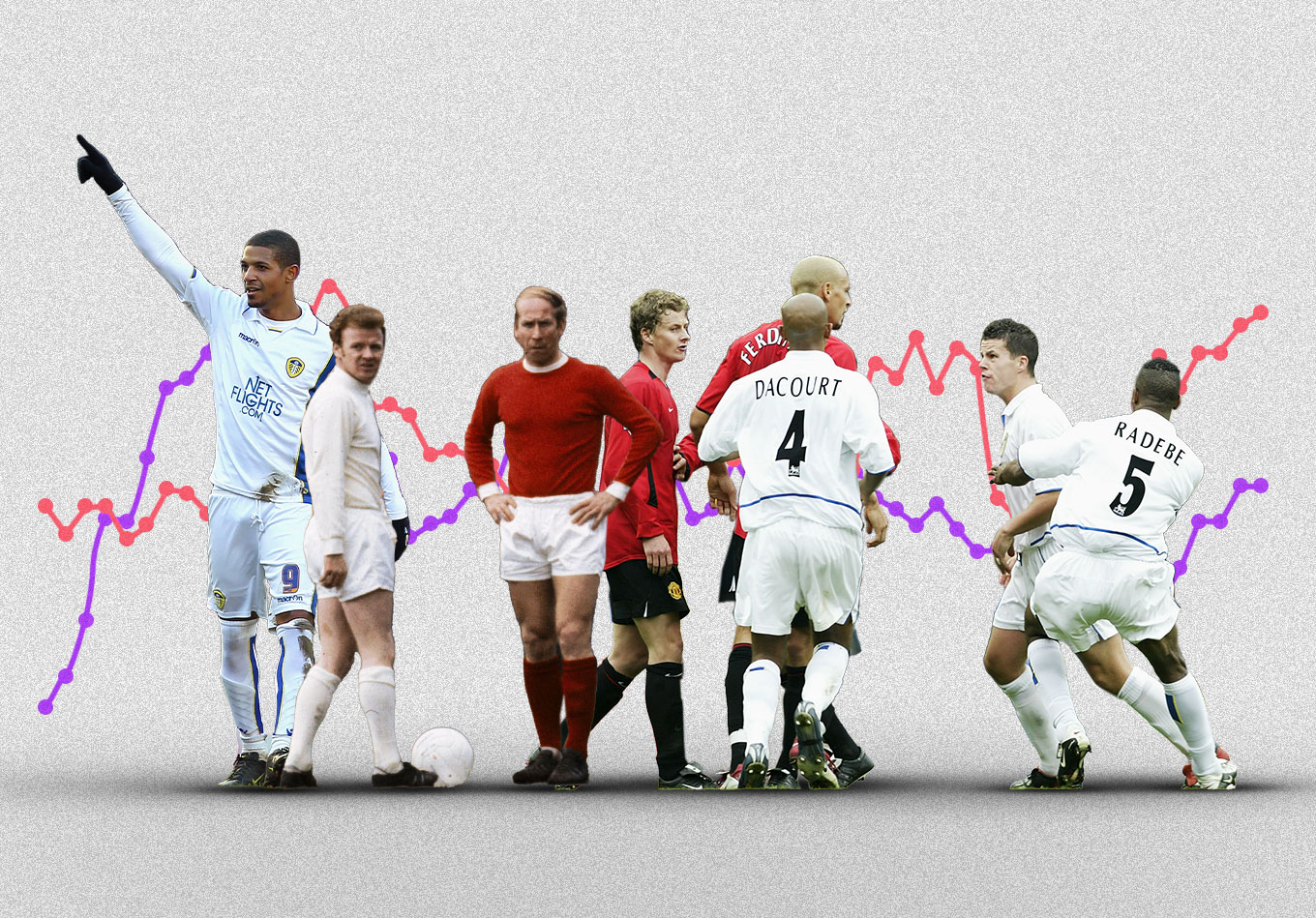You may not be aware, but Leeds versus Manchester United is one of England’s fiercest derbies by tradition. They face each other in the Premier League this weekend, so we decided to look at the history of the fixture with a delightful array of data viz.
The derby between Leeds United and Manchester United pits one of the strongest sides in Yorkshire against one of the biggest in Lancashire (historically, at least). With the two counties having such a rich, historical divide over centuries of English history, that rivalry is now witnessed through one of societies biggest vehicles of emotive display: football.
As the official Manchester United website stated in 2019: “The War of the Roses in the 15th Century, fought between the House of Lancaster (the red rose) and the House of York (the white rose) created a sense of bitterness between the two areas from either side of the Pennines that has never truly disappeared. The fact one team plays in red and the other in white (well, since 1961 anyway) only accentuates that link. It is also a fact that Manchester and Leeds were rivals for business during the Industrial Revolution during the 18th and 19th centuries, and even now compete for new companies investing in the cities.”
The History
“Utter hatred” is how the rivalry between Leeds United and Manchester United was described by Sir Alex Ferguson, although, he did also say, “There was something about the hostile atmosphere at Elland Road that I quite liked.”
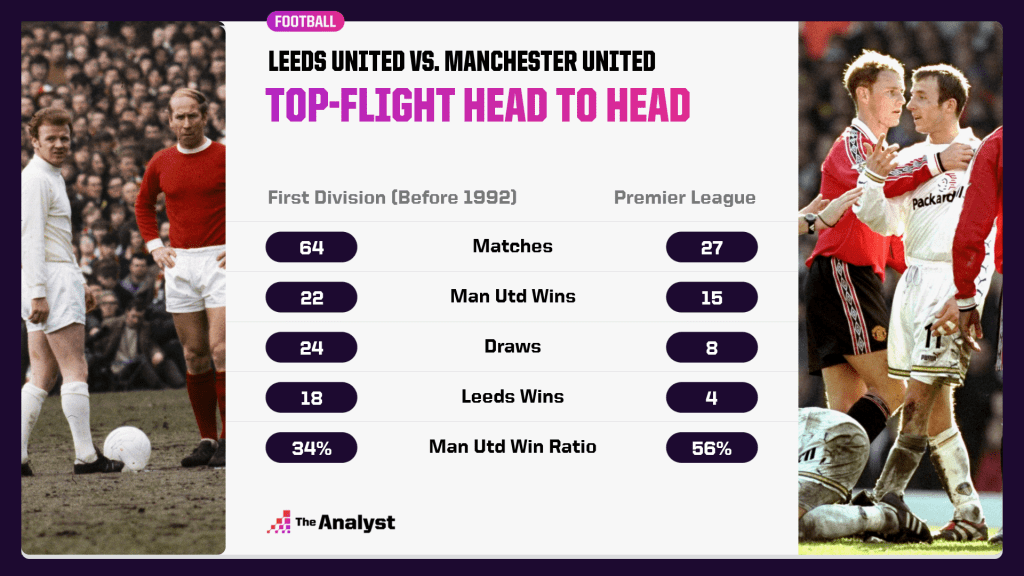
One such game between the teams at Elland Road came in December 1991, when the two great rivals were the best in the country and locked in a battle for the English top-flight title – something that had eluded Man Utd since 1967 and Leeds since 1974. The game ended in a 1-1 draw in which a Mel Sterland penalty cancelled out Neil Webb’s opener, leaving the sides level at the top on 34 points. Come the end of the 1991-92 season, Leeds finished four points clear of runners-up Manchester United to win the league, with the trophy lifted by their flame-haired captain Gordon Strachan, who was sold to Leeds in 1989 by the Red Devils.
It gave Leeds their third top-flight league title, following successes in 1968-69 and 1973-74, only four fewer than Man Utd’s seven up to that point.
Then the Premier League happened.
Since the inaugural Premier League season in 1992-93, Leeds United haven’t won a single top-flight title, while Manchester United have won the most (13) in the ‘new era’ of English club football.
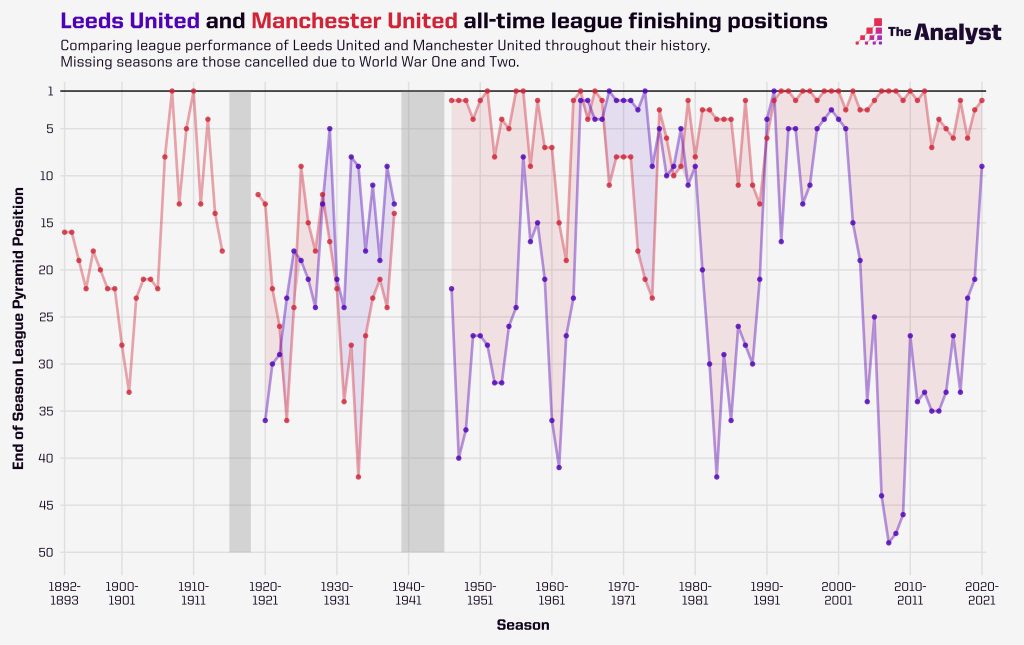
Leeds and Manchester United have spent 48 seasons in the same division – three in the second tier in the 1920s and 30s and the other 45 in the top flight. Of the 47 seasons before this current one, the Red Devils have finished above their Yorkshire rivals in 30 of those campaigns, including in every single Premier League season.
The rivalry between the sides has geographical and historical reasoning, but in footballing terms the animosity and rivalry only really began during the 1960s when Leeds, under their most successful manager Don Revie, returned to the top flight in 1964 and began challenging for the title.
In their first season in the top flight under Revie, Leeds came second to Sir Matt Busby’s Manchester United on goal average after tying on 61 points. It’s one of only six occasions in English top-flight history the title has been decided on goal average or goal difference, and something repeated only twice since – 1988-89 between Arsenal and Liverpool and 2011-12 between Manchester City and Manchester United.
Although Man Utd finished above Leeds in two of the next three seasons, Leeds then spent the next six seasons above their rivals in the table, winning two titles in the process. The second of these came in 1973-74 and saw Manchester United relegated in 21st place.
During this period, Leeds enjoyed a 13-game unbeaten run against Man Utd in all competitions between November 1967 and December 1972, the joint longest that the Manchester club have ever gone winless against an opposition team in their entire history, and something that hasn’t been repeated since.
This sequence of results also means that Revie is the only manager in history to go 13 matches without defeat against Manchester United.
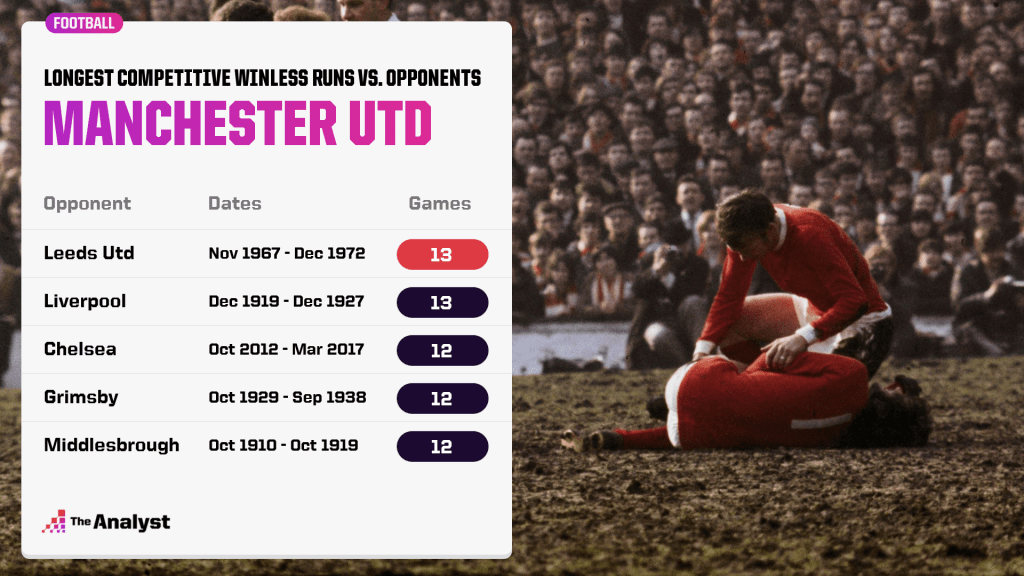
Whilst we’re predominantly focusing on league action between these two clubs, the FA Cup has also offered up 10 meetings between these two clubs. It’s a competition that has been won by Manchester United 12 times overall compared to just the one by Leeds – in the 1972 centenary final versus Arsenal.
The sides have met in three different semi-finals in the competition, with Leeds winning two – in 1965 in a replay and 1970 in a second replay, both times 1-0 wins via a goal from Billy Bremner – and Man Utd winning 2-1 at Hillsborough in 1977, a year they went on and won the trophy.
When they met in the third round of the competition in January 2010, Leeds arrived at Old Trafford as the top team within the third tier of English league football, while Manchester United were second in the Premier League. Despite this, Leeds famously eliminated their rivals on their home turf thanks to a goal from Jermaine Beckford and condemned Ferguson to his only FA Cup defeat against a side from a lower division and one of only four occasions that his Manchester United team lost a home game against opposition from outside the top-flight:
September 1995 – League Cup 2nd Round (First Leg): Lost 3-0 versus York City
September 2007 – League Cup 3rd Round: Lost 2-0 versus Coventry City
January 2010 – FA Cup 3rd Round: Lost 1-0 versus Leeds United
November 2011 – League Cup Quarter Final: Lost 2-1 versus Crystal Palace
The Premier League Era
Manchester United’s dominance in the Premier League era – particularly in the early years when they won four of the first five titles – has often been linked to the signing of Eric Cantona from Leeds in November 1992. The Frenchman had previously won the 1991-92 top-flight title with the Whites and then played against Man Utd for Leeds in their first Premier League meeting.
After debuting for the Red Devils in December, he scored nine times and assisted 11 goals in 22 Premier League appearances, ending on the losing side only once, and winning 68% of the games he featured in. By contrast, without him that season, Man Utd won 45% of their games.
Between his debut for them in December 1992 and the end of the 1996-97 season, when he retired, only Alan Shearer and Les Ferdinand were involved in more Premier League goals than Cantona (64 goals, 51 assists). Three of his goals in the competition came against Leeds – including one in a 4-0 win at Elland Road in what was his former manager Howard Wilkinson’s last game in September 1996 – with no former Leeds player scoring more times against them in the Premier League.
In the Premier League, Leeds have had a win ratio of just 15% and a points per game average of 0.74 against Manchester United, which is lower than any other opposition that they have faced at least five times, while they have only lost more often against Liverpool (16) overall in the competition than they have against the Red Devils (15).
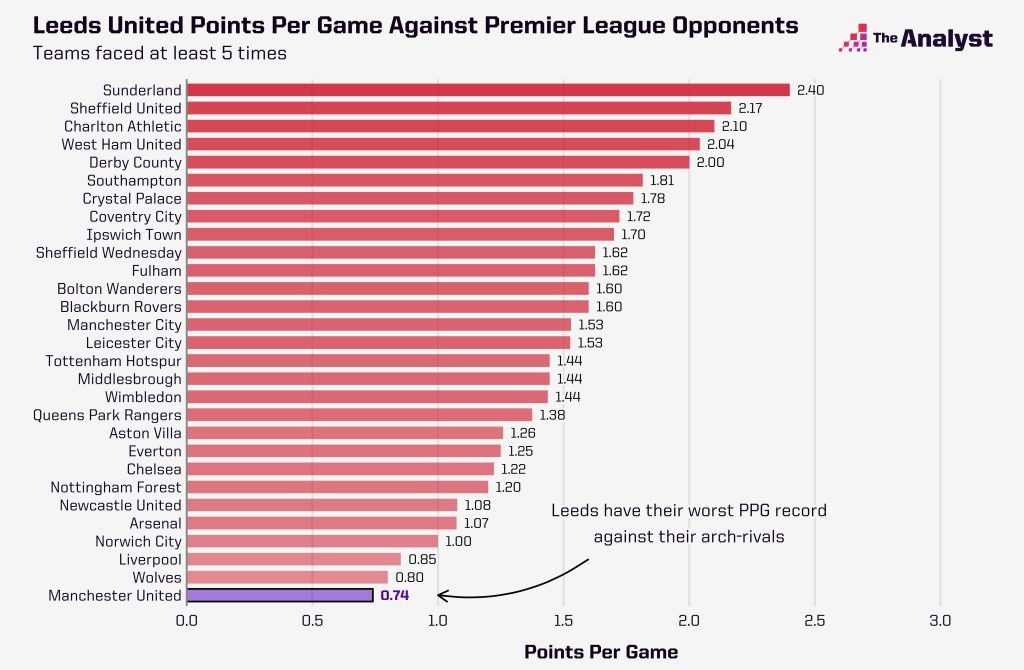
Manchester United have also played more Premier League games at Old Trafford without losing against Leeds than any other side (14) and have scored 11 goals in just two games against them at Old Trafford since Leeds returned to the top-flight in 2020: a 6-2 win in December 2020 and 5-1 in August this season. That 6-2 victory was the first time they had scored six against Leeds since a 6-0 win in September 1959.
Although they’ve only faced them three times under Marcelo Bielsa, no side has scored more times against his Leeds team than Man Utd (11). This is made all the more striking considering the fact that in the other game they shut them out in a goalless draw.
The Season So Far: Leeds
At the bottom end of the table, Leeds are suffering through what happens when a team set up to score goals stops scoring as much as they previously did.
As injuries have bitten – most notably to last season’s 17-goal man Patrick Bamford – Marcelo Bielsa’s thinly constructed squad has struggled to replicate their results of last term, slipping from a ninth-place finish to the vicinity of the drop zone this time round.
Unfortunately for the Yorkshire side, their slide could hardly be called an aberration. Leeds have rarely maintained consistent defensive numbers since returning to the Premier League, but it is more damaging than ever this season for two reasons: they’re no longer scoring at a sufficient rate to off-set their defensive fragility, and they’re currently in their most extended period under Bielsa in terms of giving up chances.
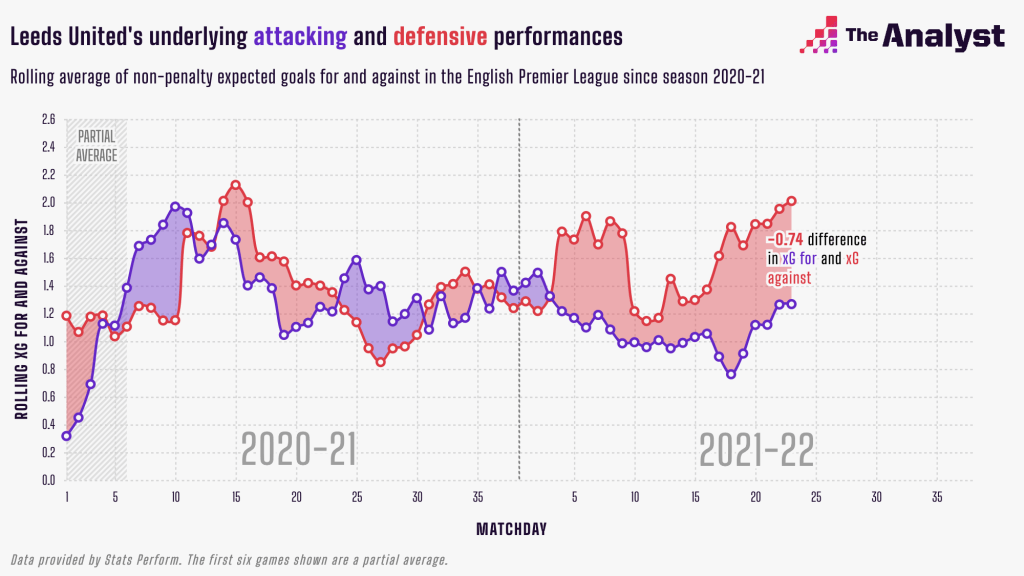
Leeds were a dominant team in the Championship under Bielsa, controlling possession and in turn controlling the share of chances at both ends. That was never going to translate to the Premier League entirely, but in the first season their front-foot nature put them in a different category to those who look to stave off relegation with deep defensive units. In 2021-22, the vulnerability of Bielsa’s approach when it is missing many of its key drivers has been stark on numerous occasions.
Talk of how things would be different were it not for injuries is always hypothetical, but Leeds are arguably the Premier League’s most penalised team when it comes to absences – even if it is partly their own fault. Kalvin Phillips and Patrick Bamford have played just 48% and 22% of possible minutes in the competition this season respectively, with the former a star of England’s Euro 2020 run, and the latter being outscored by only three players in the Premier League last term.
Those losses to the spine of their team are tough to overcome and have been compounded by the combination of Leeds’ lack of transfer activity and Bielsa’s small group of existing first team players.
The Season So Far: Man Utd
Up at the top end, Manchester United were being talked of as title outsiders after obliterating Leeds on the opening day of the season. Jadon Sancho and Raphaël Varane had already signed up, while Cristiano Ronaldo had followed just a few weeks later. On the surface, it seemed a formidable squad.
Six months on, Ole Gunnar Solksjaer is gone and Ralf Rangnick’s task of steadying their path is not proving to be straightforward. While they’ve only lost one of their 11 league games to date under Rangnick, the product on the pitch has not been quite as advertised in respect to his famous pressing style. The make-up of their six victories to date is also notable, given that four have come against bottom-half teams. Their most recent – a 2-0 win over Brighton & Hove Albion – comes with the asterisk of playing against 10 men for most of the second half, following an underwhelming first period.
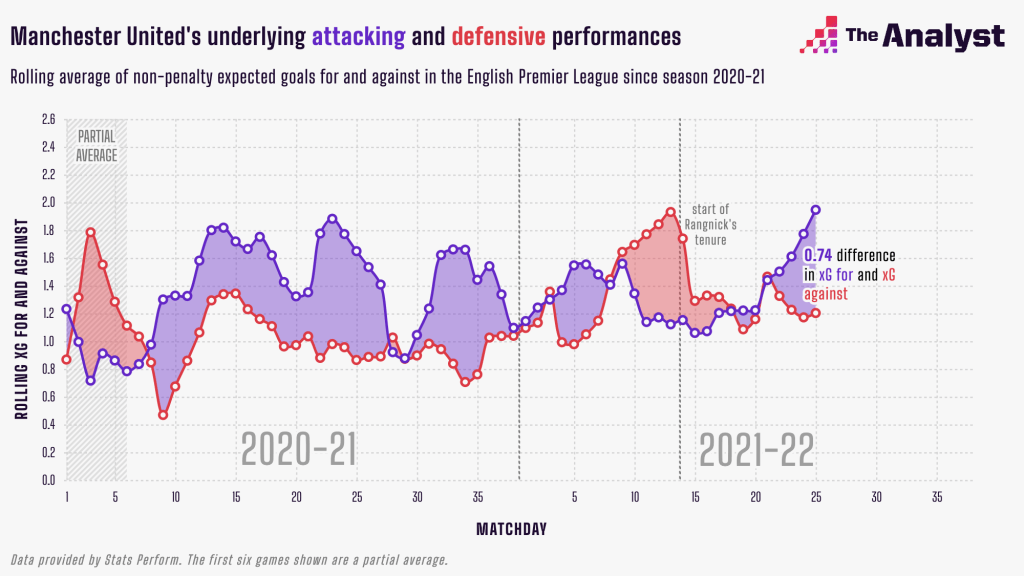
In terms of their underlying performance, it would be fair to say the window for the ‘new manager bounce’ has elapsed without much effect for Rangnick. After a mixed start in which they struggled to attain any real advantage between creating chances and preventing them, their recent uptick has then been accompanied by struggles with converting their opportunities. Whatever lies ahead for the German doesn’t seem like it’s going to come easily.
Of course, we can’t talk of goalscoring without mentioning Ronaldo. One of the deadliest finishers in the history of sport hasn’t looked much like his reputation so far, scoring his seven non-penalty goals from an expected goals total of 9.7. Not all of it is down to outright poor finishing from Ronaldo, who at 37 years old now relies on creation from teammates as much as he ever has. His lack of big chances from open play – comparative to his usual career supply – is a symptom of Manchester United’s creation on a team level.
Ronaldo’s last appearance at Elland Road came in October 2003, in what at the time was only his second start away from home in the Premier League. He was a flying winger back then, who David Batty delighted in welcoming with an elbow to the stomach that earned him a first-half booking. Ronaldo’s return 18 years later will bring a much different version, albeit with just the same appetite – even if his teammates can’t put it on a plate for him.
The Styles
Leeds and Manchester United are two of the quicker attacking teams in the Premier League in terms of how they fashion their most damaging offensive moves. In fact, since Rangnick’s first game on 5th December, the two teams who have recorded the most direct attacks in the Premier League have been Leeds (25) and Manchester United (22).
Over the whole season, the two teams rank in the Premier League’s top six for possession average, with Leeds fifth and Manchester United sixth. The distinction is that they are also two of the quicker teams in advancing the ball up the field, as evidenced by our direct speed metric, where Leeds (1.61 metres per second) and Manchester United (1.59m/s) rank within the top seven sides. In short, the two teams combine higher rates of possession with above-average speed in getting from A to B.
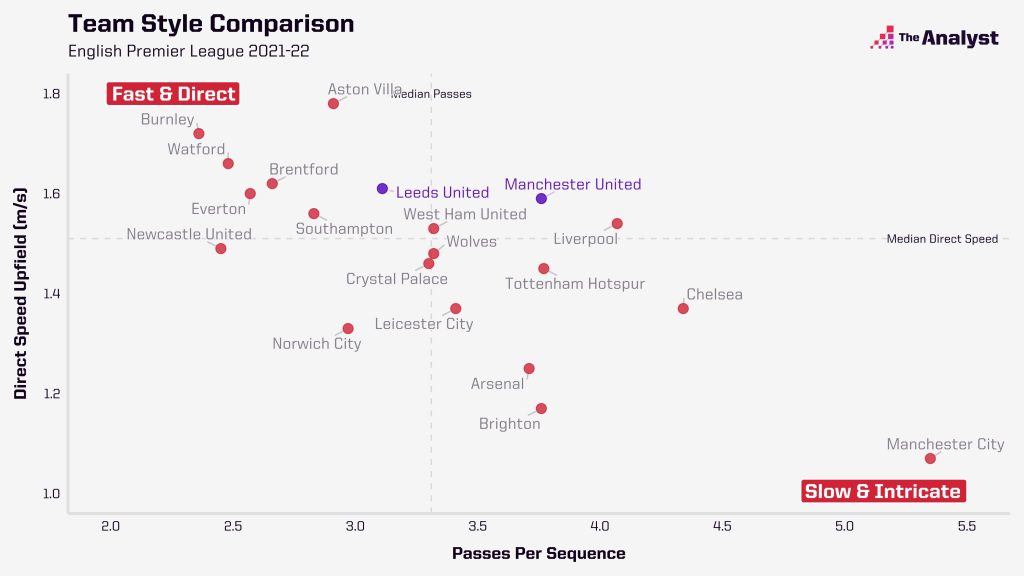
The combination of the Elland Road atmosphere and a duel between Marcelo Bielsa and Ralf Rangnick – two coaches affiliated with high-pressing styles – is likely to make for a game without much settled possession. Leeds will want to swarm the away side underneath the cascading noise, while Rangnick’s men are also likely to get drawn into an energetic game more in line with his own pressing style.
At the same time, both teams will also be aware of the vulnerabilities of each other when pressured. Since 5th December, Leeds (10.4) and Manchester United (nine) are two of the five teams who have suffered the most high turnovers against per game in the Premier League. In the case of the former, the Whites have both conceded the most shots (22) and goals (three) following high turnovers in this period.
Following their successful season back in the Premier League last season, opposition teams have gotten wiser to Bielsa’s high-intensity running and pressing style at Leeds. In order to try to nullify this, teams usually become more direct against them in the competition – something that has become clear this season. Teams have had an average direct speed of 1.84m/s against Leeds in the Premier League this season, while making an average of just 2.5 passes per open-play sequence – both outliers in the competition in 2021-22.
Against a Leeds team that likes to press high up the pitch, there will always be gaps left in their defensive third upon fast transition. Play a quick and direct attacking game against them, and you’ll be able to exploit this more often than not.
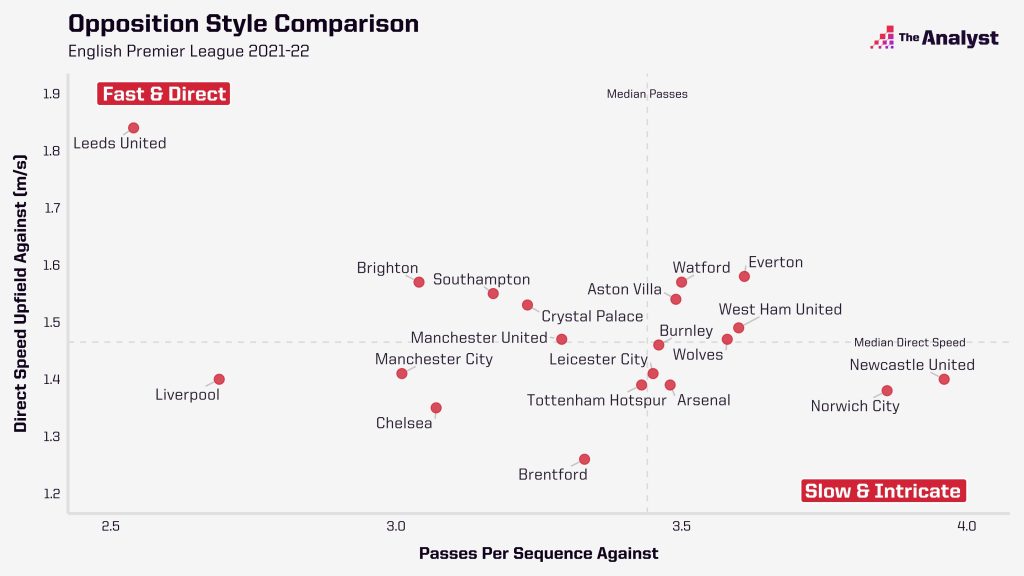
Field tilt is a metric to show the territorial dominance between teams. Put simply, it measures the share of possession a team has in a game, considering only touches or passes in the attacking third. It can be useful when trying to understand which team is more dominant in games, rather than looking at overall possession, mainly as it looks at how teams are able to get the ball into areas that matter.
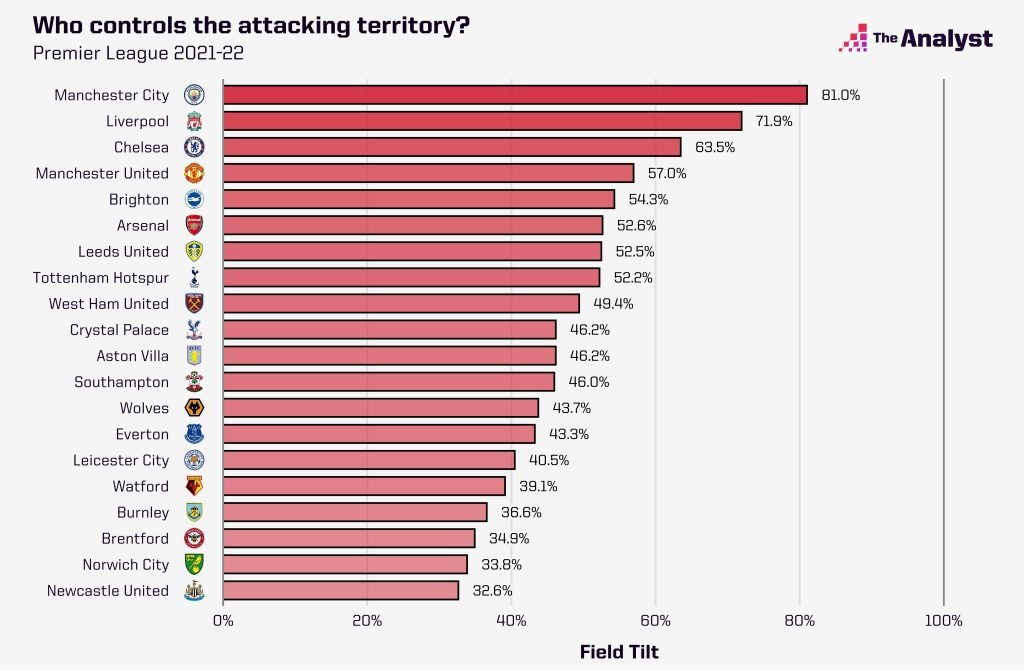
Manchester United (57.0%) feature fourth in this metric across the 2021-22 Premier League season, while Leeds United are the seventh highest (52.2%) – the only team in the bottom half of the league table to have an average above 50%.
Since Rangnick arrived at the club, Manchester United’s field tilt percentage has increased from 54.2% (which was lower than Leeds’ 55.2% upon his appointment) to 60.3%, showing that the new head coach has tried to take the game to opponents more than his predecessor did this season. However, this could also be down to the quality of opposition faced under Rangnick’s tenure so far. Only two of his 12 games have come against sides placed in the top eight on the day of the game.
Will Manchester United finally embrace Rangnick-ball and go hunting a vulnerable Leeds side? Or will Leeds welcome a punch-for-punch encounter, knowing Elland Road can supercharge their intensity? In the stands and between the white lines, it could well be chaos in Yorkshire.
Additional data viz support from Peter McKeever and Jon Manuel, banner image by Matt Sisneros.
Enjoy this? Subscribe to our mailing list to receive exclusive weekly content.
